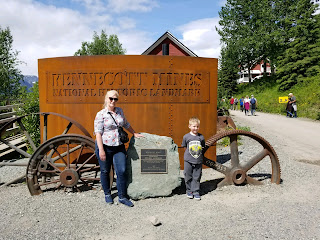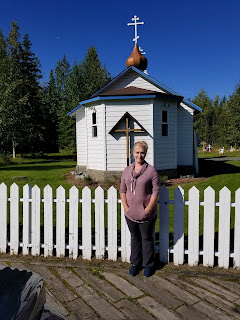Kennecott Mine
History
 |
| Abandoned Railway |
A town and railroad had to be built in one of the most
secluded areas one could find. This is a place where in the winter the sun only shines a few
hours and temperatures can easily reach 60 below 0. Equipment had to be
brought in on dog sleds and in 1907; construction on the Copper River &
Northwestern Railways began. The 196-mile railroad stretched from
Cordova to Kennecott and included over 40 miles of bridges and trestles; it
cost 25 million dollars to build. Construction of the railroad took 4 years and over 1000
workers who had to work in dangerous conditions that included mountain drop
offs, glaciers, snow, and avalanches, many workers lost their lives during
constructions. The railroad called CR&NW for short was often referred to as
“ Can’t Run & Never Will”.
The railroad was completed in 1911 and the first shipment of
ore was sent out, over the next 27 years until the last train pulled out in
1938 the mine had gross revenues of over 200 million and net profits of over
100 million dollars.
During its heyday Kennecott had about 500 residents, the
town had bunkhouses for the miners, a hospital that boasted the first x ray
machine in the state with people coming in on the train from all over to have
their x-rays done. There was a recreation hall, a dentist, a school and some
shops as well. Towering over it all along the hillside sits the Mill. Today most
of these building remain and visitors are able to walk inside getting a taste
of how life might have been.
The mine closed only two days a year, Christmas Day and the 4th of July. The rest of the year miners worked 8 hour shifts with the mine running 24 hours a day.
The mine closed only two days a year, Christmas Day and the 4th of July. The rest of the year miners worked 8 hour shifts with the mine running 24 hours a day.
 |
| The Mill |
 |
| Main Street |
On November 10, 1938 the last train left Kennecott, the few
people left in town had only a few hours to pack their belongings and make
the train or be left to find their own way out. The town was left a ghost town with only
three watchmen remaining until the mid-1950’s. The town then sat empty with just
a handful of people who lived in nearby McCarthy or on private property in the area to
keep an eye on it until the 1980’s when it became a tourist destination.
Today if you want to visit Kennecott, you must either fly on
a small plane to McCarthy or drive McCarthy road, which follows the right of
way of the original Copper River and Northwestern Railways. Even by Alaskan
standards this road is rough with potholes, sharp rocks and warning of old
railroad spikes that can easily take out a tire or two.
Along the way you can see the remains of trestles that were
built and you will drive across the one way Kuskulana Bridge, a steel truss
bridge that was built for the railroad in 1910.
 |
| Kuskulana Bridge |
When you reach the end of the road, literally you must park and
walk across a footbridge where you can catch a shuttle into either McCarthy or
Kennecott.
 |
| Foot Bridge |
Ghost Stories
 |
| On top of the mill |
 |
| Inside the mill |
While operating the mines and town would have seen many deaths to include
two Swedish miners who suffocated to death inside one of the mines in 1912, an
Italian miner who was buried in a rock slide and many others who fell to their
deaths inside mine shafts, were hit and killed by falling debris or who fell from
or were decapitated riding the tram to and from the mines.
 |
| Hospital and Dining Hall |
Men came from all around the world searching for opportunity
and higher wages, some left quickly finding that the harsh weather conditions
and difficult work where not worth the “ higher” wage, others left when the copper
ran dry and the mine closed, but some might still be there today, watching over the
town and observing those of us who come for a visit.











Comments
Post a Comment